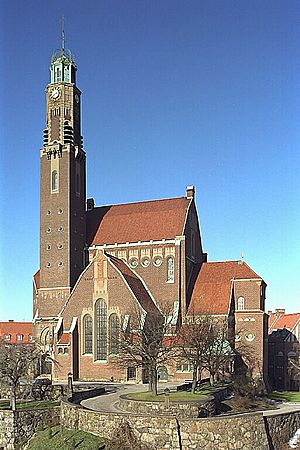Engelbrekt Church facts for kids
Quick facts for kids Engelbrekt Church |
|
|---|---|
|
Engelbrektskyrkan
|
|

Engelbrekt Church
|
|
| 59°20′39″N 18°04′04″E / 59.34417°N 18.06778°E | |
| Location | Lärkstaden, Stockholm |
| Country | Sweden |
| Denomination | Lutheran, Church of Sweden |
| Website | svenskakyrkan.se/engelbrekt |
| Architecture | |
| Architect(s) | Lars Israel Wahlman |
| Style | National Romantic style |
| Groundbreaking | 14 May 1910 |
| Completed | 25 January 1914 |
| Administration | |
| Parish | Engelbrekt Parish |
| Diocese | Diocese of Stockholm |
Engelbrekt Church, also known as Engelbrektskyrkan in Swedish, is a beautiful and important church in Stockholm, Sweden. It is a protected building because of its special history and design. The church belongs to the Church of Sweden and serves the Engelbrekt Parish.
This amazing building was designed by the architect Lars Israel Wahlman. It was finished in 1914 and is known for its unique National Romantic style. With 1,400 seats, it is one of the biggest churches in Stockholm.
Contents
Why is it called Engelbrekt Church?
The church is named after Engelbrekt Engelbrektsson. He was a Swedish hero from the 1400s who led a rebellion. Naming the church after him was a way to celebrate Swedish history and national pride.
The church was built on top of a hill between 1910 and 1914. The architects decided to leave the natural rock mostly untouched. This made the church stand out even more, giving it a naturally high and impressive spot in the city.
What makes its architecture special?
Engelbrekt Church has some features that remind people of Byzantine architecture. It has a special cross-shaped design, which is called a cruciform architectural plan. The main part of the church, called the nave, is 32 meters (about 105 feet) high. This makes it the highest church nave in all of Scandinavia.
Architects around the world admire this church. It has not been changed much since it first opened. It is seen as a perfect example of the Swedish Art Nouveau era and the National Romantic style.
See also
- List of churches in Stockholm
- List of highest church naves
External links
- Panorama of the interior

